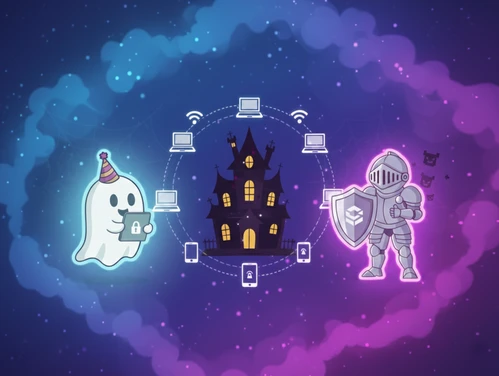Making cybersecurity less of a trick and more of a treat.
This October, as spooky season approaches, the ICN is teaming up with Iowa Homeland Security and Emergency Management (HSEM) to ensure Iowans are protected from digital ghosts and goblins. As state agencies, our shared mission is to keep our communities safe.
We will spotlight the Core 4 cybersecurity practices—four essential habits that can significantly reduce the risk of cyber threats:
- Strong Passwords Are Your First Line of Defense
- The Power of Multi-Factor Authentication (MFA)
- Don't Hit "Remind Me Later": The Spell of Patches and Updates
- Protecting Against Phishing and Social Engineering
With cyber threats lurking in the shadows, it’s a big job that requires a team effort. Follow both agencies so you don't miss any of the digital content we'll be posting.
- Facebook: @IowaHSEM, @IowaCommunicationsNetwork
- LinkedIn: ICN
- X: @IowaHSEM
Also check out our cybersecurity tips and HSEM's ReadyIowa.gov. By working together, we aim to make cybersecurity less of a trick and more of a treat for everyone.
---
The Digital Foundation: Strong Passwords Are Your First Line of Defense
Imagine your online accounts as a house. Your password is the front door lock, it's the first and most crucial barrier against intruders. A weak, easy to guess password is like a skeleton key, making it effortless for cyber criminals to waltz right in.
To build a strong digital foundation, follow these "spooky-proof" password rules:
- Unique to Each Account: Never reuse passwords. If a cyber criminal cracks one, they could unlock all your accounts.
- At Least 16 Characters Long: Think of this as adding deadbolts to your door. Longer passwords are exponentially harder to break.
- A Random Jumble of Characters: A mix of letters, numbers, and symbols is the most secure. Avoid using common words, names, or birth dates.
To make this simple, consider using a password manager. This tool is a digital vault that creates and stores strong, unique passwords for all your accounts, so you only have to remember one master password. It's the simplest and most effective way to secure your online life.
---
Beyond the Lock: The Power of Multi-Factor Authentication (MFA)
A strong password is a great start, but even the best locks can be picked. That's where Multi-Factor Authentication (MFA) comes in. Think of MFA as a second layer of security, like a security alarm system for your digital home. Even if a cybercriminal somehow gets your password, they can't get in without the second piece of information.
MFA uses something you know (your password) and combines it with something you have (like a code sent to your phone) or something you are (your fingerprint or a face scan). Popular forms of MFA include:
- SMS Text Codes: A one-time code sent to your phone.
- Authenticator Apps: Apps like Google Authenticator or Microsoft Authenticator generate a unique code every 30 to 60 seconds.
- Biometrics: Using your fingerprint or face to verify your identity.
Don't let a password be the only thing protecting you. Build on your strong foundation with MFA to create a truly resilient defense.
---
Don't Hit "Remind Me Later": Cast the Right Spell with Patches and Updates
We all get those pop-up notifications, "A new software update is available." It's tempting to hit "remind me later," but ignoring these alerts is one of the most dangerous things you can do. These aren’t just about new features, they're often critical security patches that fix vulnerabilities, the digital cracks in your armor that cyber criminals could exploit.
The ICN relies on regular updates to keep our network secure, and you should too. Consider each patch a powerful spell against digital ghouls and goblins. Turn on automatic updates for all your devices and software to ensure your systems are always protected. Being prompt with your patches protects your data and ensures your devices and applications are running as they were designed to.
---
The Human Firewall: Protecting Against Phishing and Social Engineering
The most powerful firewall isn't a piece of software, it's you. While technology provides a powerful defense, cyber criminals often exploit the human element through social engineering. This is a collection of tactics used to trick people into giving up confidential information. Phishing, a common form of social engineering, uses emails, texts, and fake websites to lure you into revealing personal or financial details.
Be your own "human firewall" by learning to spot the red flags:
- Emotional Appeals: Messages that create a sense of urgency, fear, or excitement to pressure you into acting quickly.
- Unusual Requests: Be cautious of unexpected requests for personal information. Legitimate organizations rarely ask for sensitive details via email or text.
- Spelling and Grammar Errors: Scammers often make mistakes. Look for typos and awkward phrasing.
- Suspicious Links: Don’t click on links or open attachments from unknown senders. When in doubt, delete the message.
Trust your gut. If something feels out of place, slow down, verify the request through a trusted source, and avoid giving in to pressure. By being aware and vigilant, you can defeat even the most clever digital tricks.
